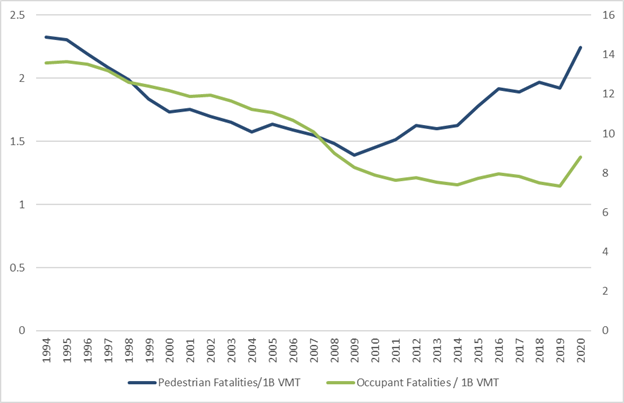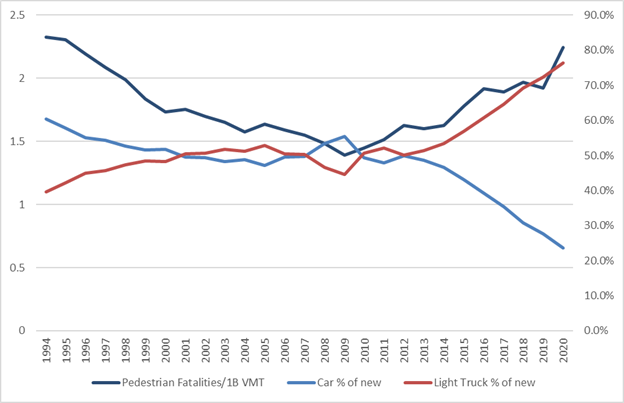- Automobile Industry
- PUBLIC SAFETY
- LIGHT TRUCKS
- Driver Assistance Systems
- Sensors
It’s Time to Focus on Pedestrian Safety

For many decades, the US saw a relatively steady decline in traffic fatalities as road infrastructure, vehicle technology, and driver behavior (in the form of reduced impaired driving and use of seat belts) improved. Unfortunately, the past 14 years, and especially the last 3, have seen a reversal of that trend. While correlation should never be confused with causality, some rather disturbing parallels can be found in an examination of safety and sales data. In particular, much of the increase in fatality rates is among pedestrians, and it correlates directly with a rapid market shift from cars to light trucks.
The Fatality Analysis Reporting System (FARS) from the National Highway Traffic Safety Administration (NHTSA) is a valuable source of data for analyzing what is happening on the nation’s roads. FARS breaks out fatalities among drivers, passengers, pedestrians, cyclists, and motorcyclists. Normalizing the data to annual vehicle miles traveled (VMT) and plotting pedestrian and vehicle occupant deaths shows that from 1994 through 2009, both categories were on a similar downward trend before they diverged.
Pedestrian vs. Vehicle Occupant Fatality Rates

(Source: Guidehouse Insights)
Occupant deaths (drivers and passengers) continued to trend downward until 2020. Since then, crashes and fatalities have increased, at least in part due to behavior changes during the COVID-19 pandemic such as more speeding and drinking. During that same period from 2009 onward, pedestrian deaths have climbed steadily from 1.39 deaths per 1 billion VMT to 2.24 in 2020. Preliminary data for 2022 indicates that the rate has increased to 2.37 deaths per 1 billion VMT, with more than 7,500 pedestrians killed last year—about 2,000 more than in 1994 and the highest total since 1981.
What’s so special about 2009? It was the year following the great financial meltdown. There was a major recession, and new vehicle sales dropped from a high of nearly 17 million to just over 10 million. More importantly, of the vehicles being sold, an ever smaller percentage were cars, with consumers increasingly opting for SUVs and pickup trucks. While the light truck share had been creeping up since the mid-1990s until it peaked at about 50% around 2006-2007, it declined when gas prices went up to about $4 per gallon before the recession.
Following the meltdown, oil prices dropped for a time along with economic output, and as vehicle sales slowly recovered, the market again shifted toward light trucks, and it hasn’t let up since. In 2020, light trucks accounted for nearly 77% of US sales.
Pedestrian Fatalities and the Rise of Light Truck Sales

(Source: Guidehouse Insights)
Consumers say they appreciate the added visibility of light trucks, enabling them to see over other large vehicles by sitting up higher on the road. However, that increased height also tends to severely restrict visibility of what’s around the vehicle, including pedestrians. A 2021 study by Consumer Reports revealed that trucks’ hood heights had increased by 11% since 2000, and some, such as the Ford F-250, had hoods as high as 55 inches, easily hiding smaller cars and pedestrians from view.
While a market shift away from these larger vehicles would certainly help, it’s unlikely to happen soon. The recent notice of proposed rulemaking by NHTSA to enhance automatic emergency braking (AEB) should also help if implemented, but that’s not likely before 2026 or 2027 and could be longer depending on the results of the 2024 election. NHTSA should also be considering minimum visibility requirements, but that’s a topic for another day.
Regardless of what regulators and consumers do, the industry has an opportunity to step up and address this problem sooner. New sensor technologies like imaging radar, thermal imagers, and lidar, along with more external cameras, can at least provide drivers of all vehicles with greater situational awareness. Automakers can also make AEB much more robust without waiting on NHTSA to act. Walking and cycling more is a key part of the sustainability puzzle; let’s make it safer to do so.